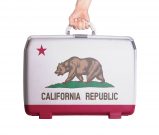Focusing on the long-term causes of California's plight the New York Times is offering its readers the journalistic equivalent of comfort food.
Our Polarized States: Two Cheers
The Washington Post’s Dan Balz is a well-informed observer of (among other things) political polarization among states. One of his earlier pieces is here along with a few comments by yours truly. Yesterday’s Post has another long-front page Balz article on the subject, along with a companion piece on Texas and California –mega-states that have adopted very different social models.
Polarization (whether measured by single-party control over states, policy outcomes, or whatever) has its downsides. Single-party states may start to work like the House of Commons and “overshoot” in a red or blue direction. At the federal level, a polarized system is bound to produce politicians who aren’t used to compromise; and unless one or the other party rakes all the chips off the table, you can’t get a darn thing done in Washington.
On the other hand: as noted before (e.g. here) the right, “competitive” kind of federalism requires a certain degree of polarization (or sectionalism). And the price may well be worth paying. Consider a few well-understood but underestimated advantages:
· Competitive federalism reveals information. We can debate the abstract advantages of “red” or “blue,” “American” and “European” social models until the cows come home: there’s no substitute for observing the actual effects in real life.
· Competitive federalism satisfies preferences. A thoroughly blue or red United States would leave one half of the country very unhappy. That’s not true under federalism—not when preferences are heterogeneous across states and (relatively) homogeneous within states. As, increasingly, now.
· Competitive federalism reveals preferences and reduces ignorance. People move across states lines in response to a ton of factors (climate, jobs, housing costs…)—many of which are policy-dependent. “Foot-voting” is a pretty good political feed-back mechanism: sooner or later, (state) politicians will pay attention. And as my colleague Ilya Somin has argued in a recent book, there’s no incentive to cast an informed vote for the House, Senate or President; so people vote in near-total ignorance. They don’t vote that way with their feet, for obvious reasons.
You can’t have those sweet advantages without the bitter; the trick is to minimize the costs. Here, that means national-level solutions that allow the states to go their own way, instead of entangling them in federal schemes. Dan Balz thinks we’re moving in that direction, and so do I.
A few quick words about California and Texas: you can make a serious case that these states are really too big for the United States. Whenever we had a choice, we’ve made states roughly equal in size (that’s why the prairie states look so similar, and how Michigan ended up with a piece of real estate that obviously belongs to Wisconsin). Due to the way we acquired Texas and California, that wasn’t doable and so here we are. All things equal it’s not good to have two or so big whales and a bunch of pilot fish: what if the big guys start swimming in the same direction? It’ll look like the EU.
Texas and California aren’t, and a lot depends on keeping it that way. One aspect of the competition that IMHO merits special attention:
There’s been a lot of talk about increasing inequality and the “hollowing-out” of the middle class. Some of the jeremiads are probably overblown, but the concern is real and in any event politically salient.
Who will do better in this regard—California, or Texas? My impression (as an occasional visitor) is that California is becoming a place for multi-millionaires, union members, beach bums, and welfare recipients. Everyone else is toast, or would be better off elsewhere. Texas somehow feels different. It’s at least possible that in this country, a “blue” social model means a lot more inequality.
Just a thought. Additional, better-informed thoughts invited.

